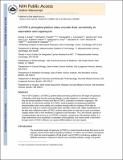mTORC1 Phosphorylation Sites Encode Their Sensitivity to Starvation and Rapamycin
Author(s)
Kang, Seong A.; Cervantes, Christopher L.; Lim, Daniel Cham-Chin; Ottina, Kathleen; Lou, Hua Jane; Gray, Nathanael S.; Turk, Benjamin E.; Pacold, Michael Edward; Yaffe, Michael B; Sabatini, David; ... Show more Show less
DownloadYaffe_mTORC1.pdf (1.695Mb)
OPEN_ACCESS_POLICY
Open Access Policy
Creative Commons Attribution-Noncommercial-Share Alike
Terms of use
Metadata
Show full item recordAbstract
The mechanistic target of rapamycin (mTOR) complex 1 (mTORC1) protein kinase promotes growth and is the target of rapamycin, a clinically useful drug that also prolongs life span in model organisms. A persistent mystery is why the phosphorylation of many bona fide mTORC1 substrates is resistant to rapamycin. We find that the in vitro kinase activity of mTORC1 toward peptides encompassing established phosphorylation sites varies widely and correlates strongly with the resistance of the sites to rapamycin, as well as to nutrient and growth factor starvation within cells. Slight modifications of the sites were sufficient to alter mTORC1 activity toward them in vitro and to cause concomitant changes within cells in their sensitivity to rapamycin and starvation. Thus, the intrinsic capacity of a phosphorylation site to serve as an mTORC1 substrate, a property we call substrate quality, is a major determinant of its sensitivity to modulators of the pathway. Our results reveal a mechanism through which mTORC1 effectors can respond differentially to the same signals.
Date issued
2013-07Department
Massachusetts Institute of Technology. Department of Biology; Whitehead Institute for Biomedical Research; Koch Institute for Integrative Cancer Research at MITJournal
Science
Publisher
American Association for the Advancement of Science (AAAS)
Citation
Kang, S. A., M. E. Pacold, C. L. Cervantes, D. Lim, H. J. Lou, K. Ottina, N. S. Gray, B. E. Turk, M. B. Yaffe, and D. M. Sabatini. “mTORC1 Phosphorylation Sites Encode Their Sensitivity to Starvation and Rapamycin.” Science 341, no. 6144 (July 26, 2013): 1236566–1236566.
Version: Author's final manuscript
ISSN
0036-8075
1095-9203